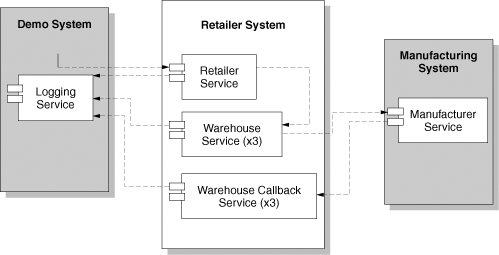Management Scenario
| These management requirements are illustrated through the Web Service Interoperability (WS-I) Supply Chain Management (SCM) Retailer System as an example, specifically the Purchase Goods Use Case. Figure 15-3 shows an overview of the features of this system. In this model, the SCM system represents an interoperable SOA-based application, where a specific subsystem, the Retailer System, operates within its own organization context. Figure 15-3. WS-I system deployment diagram To illustrate the challenges of interoperability management, the Retailer system is implemented where the web front end is implemented on the .NET platform and the Retailer service is on the Java EE platform. For purposes of illustration, the UC1 Purchase Goods use case is used, as described in the Supply Chain Management Use Case Model document [WSI1]. The use case begins with the .NET front end retrieving the catalog from the Retailer service and the customer being presented the .NET Shopping Cart page. The customer interacts with the Shopping Cart page, selecting products and setting the quantity of each ordered item. At some point, the customer is satisfied with the order and submits the order to the Retailer Service. The Retailer Service validates the order and determines which Warehouse Service will fulfill the order items. Order Validation verifies the order information is correct. If not, Order Validation sends an error message to the customer. The Retailer service then requests the products from the Warehouses. If a Warehouse is out of any of the products, it rejects the entire order and sends a response to the customer. However, when the Warehouse can fulfill the order, Order Summary sends a completion response to the customer. It is assumed that there is a common IT organization that is managing the Retailer systems and is responsible for the operation of all of its components. The SCM system follows a loosely coupled SOA architecture, where the Retailer system exists within its own organizational context and may be implemented as a tightly-coupled subsystem. The interactions between the front end and the Retailer system components is described as a request-response sequence, both for the catalog requests and for the submit order requests [WSI2]. Applying ISO Management to the Application ArchitectureThe reference system should meet requirements for the management functionality that has just been described.
The next sections outline a few management strategies that can be successfully applied across Java EE and .NET-based systems. Web services management strategy will be the starting point to demonstrate how Web services can be leveraged to manage Java EE and .NET environments. This is often referred to as Management Using Web services. The subject of Web services management is also discussed. Following the Web services discussion, the chapter explores the Platform Unification strategy and at the end compares various management techniques available in the Java EE .NET interoperability space. |
EAN: 2147483647
Pages: 170
